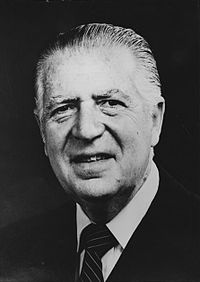Fernando Belaúnde Terry
| Fernando Belaúnde Terry | |
|---|---|
 |
|
| 57th & 60th President of Peru | |
|
In office 28 July 1980 – 28 July 1985 |
|
| Prime Minister |
Manuel Ulloa Elías Fernando Schwalb López Aldana Sandro Mariátegui Chiappe Luis Pércovich Roca |
| Vice President |
Fernando Schwalb López Aldana (1st) Javier Alva Orlandini (2nd) |
| Preceded by |
Francisco Morales Bermúdez (President of the Armed Forces Revolutionary Government) |
| Succeeded by | Alan García Pérez |
|
In office 28 July 1963 – 3 October 1968 |
|
| Prime Minister |
Julio Óscar Trelles Montes Fernando Schwalb López Aldana Daniel Becerra de la Flor Edgardo Seoane Corrales Raúl Ferrero Rebagliati Oswaldo Hercelles García Miguel Mujica Gallo |
| Vice President |
Edgardo Seoane Corrales Mario Polar Ugarteche |
| Preceded by |
Nicolás Lindley López (President of the Military Coup) |
| Succeeded by |
Juan Velasco Alvarado (President of the Armed Forces Revolutionary Government) |
|
Senator for Life Former President of the Republic |
|
|
In office 26 July 1985 – 5 April 1992 (Senate Abolished) |
|
|
Member of Parliament For Lima |
|
|
In office 28 July 1945 – 29 October 1948 |
|
| Constituency | Lima |
| President of the Popular Action Party | |
|
In office 1956–2001 |
|
| Preceded by | Party Created |
| Succeeded by | Valentín Paniagua |
| Personal details | |
| Born |
October 7, 1912 Lima, Peru |
| Died | June 4, 2002 (aged 89) Lima, Peru |
| Nationality | Peruvian |
| Political party | Acción Popular |
| Alma mater |
University of Miami University of Texas at Austin |
| Profession | Architect |
| Religion | Roman Catholic |
Fernando Belaúnde Terry (October 7, 1912 – June 4, 2002) served as the 57th and 60th President of Peru (1963–1968 and 1980–1985). Deposed by a military coup in 1968, he was re-elected in 1980 after eleven years of military rule. He was recognized for his personal integrity and his commitment to the democratic process.
The second of four children, Belaúnde was born in Lima into an aristocratic family of Spanish forebears. His father, Rafael Belaúnde Diez Canseco (1886-1972), a professor, served as Prime Minister under José Bustamante y Rivero; his paternal grandfather, Mariano Andrés Belaunde was a finance minister; and one of his great-grandfathers was a President of the Republic.
He attended the Deutsche Schule Alexander von Humboldt Lima (Colegio Peruano-Alemán Alexander von Humboldt) in Lima.
During the dictatorship of Augusto B. Leguía, the persecution for the political activities of his father Rafael and his uncle Víctor Andrés Belaúnde prompted the family to move to France in 1924, where Fernando attended high school and received his initial University education in engineering.
From 1930 to 1935, Belaúnde studied architecture in the United States, where he first attended the University of Miami (where his father was also teaching), and in 1935 transferred to the University of Texas at Austin, where he obtained his degree as an architect. He later moved to Mexico and worked as an architect for a brief time, but returned to Peru in 1936 and started his professional career as an architect designing private homes. In 1937, he started a magazine called El Arquitecto Peruano ("Peruvian Architect"), which dealt with interior design, general urbanism and housing problems the country was facing. This also gave way to the Architects Association of Peru and the Urbanism Institute of Peru.
...
Wikipedia
